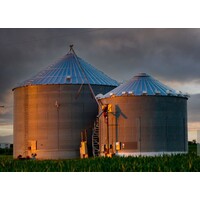
Farmers and workers are serious injured or killed every year while working on and inside silos.
The three biggest reasons are falls from heights, being overcome by oxygen depleting fumes or dust in confined spaces, and getting dragged into augers.
If you work around farm silos, you need to keep your people safe.
Workers being overcome by fumes and dust from grains while working in confined spaces has tragically led to a number of deaths on farms in Australia.
In one incident, two rescuers entered a silo in an attempted rescue and also lost thier lives.
HOW TO WORK SAFELY INSIDE SILO'S
You should only enter a confined space if you have made sure their is enough oxygen present and no risk of explosion or being engulfed.
Consider all other ways the job can be done, without entering the confined space, if you must enter, make sure you understand the risks associated both before and during the work being performed.
Make sure confined spaces are identified, and have signs on any access points to warn people against entering.
All access points like doors and hatches should be locked to prevent access.
Discuss with all workers and agree on how the work will be completed prior to entering the confined space.
Only workers who have completed confined space training, have the right equipment and a permit should enter the confined space.
Discuss and agree on the emergency procedures, BEFORE work starts, develop a rescue plan for each confined space.
You must ALWAYS have a trained safety person outside of the silo who can communicate with workers inside the confined space. Constant monitoring of the air inside the confined space is also essential with a calibrated gas detector/ monitor.
Wherever you can you must eliminate the possibility of being engulfed by product, if possible its suggested to move any product to another silo or truck during the work and avoid stepping on the product, always use a harness and lanyard secured to the outside of the silo.
NEVER enter a confined space to rescue someone unless you have been trained and have the correct equipment
OXYGEN LEVELS
In a confined space, oxygen levels can easily be affected by other gases which can cause serious risks. For example fumigation chemicals, inert gases or carbon monoxide from a combustion engine may reduce the level of oxygen in the confined space.
FIRE OR EXPLOSION
If an ignition source such as a sparking electric tool or even static electricity is introduced into a flammable or explosive atmosphere a fire or explosion is likely.
Remove all organic dust from the confined space before entering to reduce the risk of fire
RISK OF BEING ENGULFED
The risk of being engulfed should be eliminated wherever possible while working in silos by removing product prior to working in a silo.
REGULAR INSPECTION & SERVICING OF SAFETY GEAR
Ensure all your montitoring equipment, breathing apparatus and ventilation equipment is regularly inspected and is working properly.
Make sure a competent person checks any lifelines, harnesses and winches in use to make sure they are in good working condition.
You also need to create a register of confined spaces on your property and issue permits to all those that have been trained in how to work safely in confined spaces. NEVER let anyone else work in those spaces.
Make sure everyone is trained in the emergency procedures in case something goes wrong.
Always have someone else who is trained outside the silo to assist and call for help if required.
CONFINED SPACES ARE DANGEROUS, KEEP SAFE!

Leave a Comment